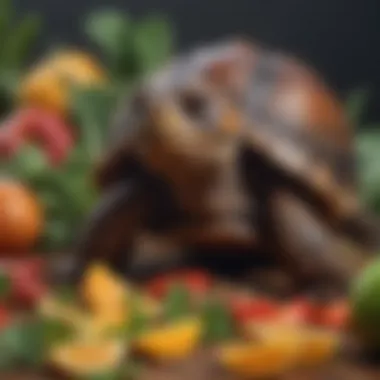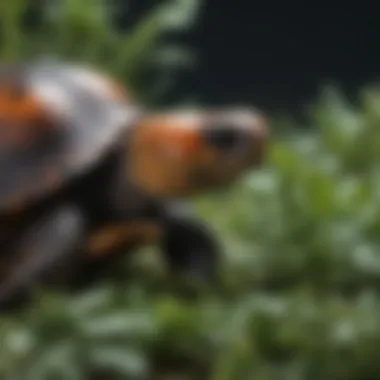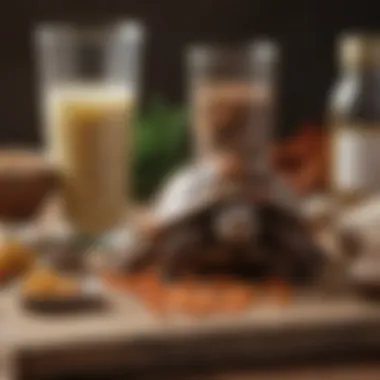Essential Nutrition Guide for Redfoot Tortoises


Intro
Redfoot tortoises, known for their vibrant shell patterns and gentle demeanor, are increasingly becoming popular pets. Understanding their dietary needs is essential for maintaining their health and longevity. This guide aims to illuminate the intricacies of Redfoot tortoise nutrition, covering aspects such as preferred food types, essential nutrients, and practical feeding strategies. With informed care practices, owners can nurture happy and thriving tortoises.
Understanding Your Pet
Pet Behavior Basics
Redfoot tortoises display unique behaviors influenced by their natural habitats. Unlike other turtle species, they are primarily herbivorous, often foraging on a variety of plants, fruits, and vegetables. This feeding behavior hints at their need for a diverse diet that mimics their natural environment. Pet owners should observe their tortoises' responses to different foods, as individual preferences can vary.
Common Breed Characteristics
These tortoises are characterized by their medium size and beautiful red and yellow markings on their shells. They can grow up to 24 inches in length in captivity, although growth rates may differ based on environmental conditions and diet. Redfoot tortoises also exhibit a slower metabolic rate, which calls for a careful approach to nutrition and feeding frequency.
Species-Specific Needs
Understanding the specific needs of Redfoot tortoises is vital. Unlike many reptiles that thrive on a diet high in protein, these tortoises require a balanced intake of fiber and moisture. Certain vitamins, such as A and D3, are also crucial for their health. Owners must provide proper environmental conditions to support their dietary habits, ensuring access to sunlight for vitamin D synthesis and maintaining adequate humidity levels in their enclosure.
Pet Care and Maintenance
Feeding Guidelines
Feeding Redfoot tortoises involves careful selection of foods. Their diet should primarily consist of leafy greens, fruits, and a small amount of protein. Common recommended foods include:
- Collard greens
- Dandelion leaves
- Sweet potatoes
- Melons and berries
Moreover, it is essential to avoid foods high in oxalates, such as spinach, as these can inhibit calcium absorption.
Grooming Essentials
While tortoises do not require extensive grooming, regular shell cleaning is necessary to prevent diseases. Use a soft brush and warm water to clean the shell gently, especially if signs of algae or dirt accumulate.
Hygiene Practices
Maintaining a clean habitat is crucial to tortoise health. Regularly replace substrate material in the enclosure, and keep food and water dishes clean to minimize bacterial buildup. Bathing tortoises weekly can also help promote hydration and overall well-being.
Health and Wellness
Routine Vet Check-ups
Regular veterinary check-ups are vital for keeping Redfoot tortoises healthy. A veterinarian who specializes in reptiles can provide essential health evaluations and guidance tailored to your tortoise's needs.
Vaccination Needs
Generally, vaccination is not common for tortoises. However, preventive measures against parasites are recommended. Regular fecal tests can help monitor and manage health.
Recognizing Signs of Illness
Awareness of common illness signs is important for tortoise owners. Symptoms like lethargy, loss of appetite, or shell abnormalities could indicate underlying health issues. Early detection can facilitate prompt veterinary intervention.
Enrichment and Activities
Indoor vs.
Outdoor Activities
Redfoot tortoises thrive with space to roam and explore. If possible, allow outdoor access in a secure area. Indoor setups can be enriched with hiding spots and climbing structures to simulate their natural habitat.
Interactive Toys and Games
Interactive elements can aid mental stimulation. Consider offering objects like cardboard or wooden boxes for exploration. These simple additions can ignite their natural curiosity.


Socialization Opportunities
Although Redfoot tortoises are generally solitary creatures, gentle interaction with their owners can be beneficial. Spending time observing them and allowing them to explore their environments can create a trusting bond between tortoise and owner.
Proper nutrition and care are paramount in helping your Redfoot tortoise thrive. The better you understand their natural behaviors and needs, the more effectively you can support their overall health and happiness.
Understanding Redfoot Tortoise Dietary Requirements
Understanding the dietary requirements of Redfoot tortoises is vital for their health and longevity. These tortoises come from specific habitats that naturally influence their food preferences. Adapting their diet to match these natural needs in captivity is essential. Proper nutrition can prevent many common health issues that affect tortoises. By learning about their dietary needs, owners can foster a thriving environment.
Natural Habitat Overview
Redfoot tortoises are native to the tropical forests of South America. Their natural habitat consists mainly of lush, humid environments with plenty of vegetation. The climate in these regions provides a diverse array of plant life. This diversity contributes to their varied diet. In the wild, Redfoot tortoises graze on a combination of grasses, fruits, and leaves. Understanding this habitat provides context for what they need in captivity. Providing a diet rich in these components fosters better health and well-being.
Nutritional Needs and Breakdown
Redfoot tortoises have specific nutritional needs that must be considered. Their diet should consist of various components, including vitamins, minerals, proteins, fats, and fiber. Each of these nutrients plays a vital role in maintaining health.
Vitamins and Minerals
Vitamins and minerals are fundamental to the overall health of Redfoot tortoises. These nutrients support several bodily functions. For instance, Vitamin A is crucial for vision and cell function. Calcium is critical for shell development but must be balanced with phosphorus. A balanced intake of vitamins and minerals helps in preventing deficiencies that can lead to health problems.
Proteins and Fats
Proteins and fats are other essential building blocks of the Redfoot tortoise diet. These macronutrients provide energy and support growth and repair of body tissues. Tortoises require moderate protein levels. High-quality sources include insects, legumes, and certain vegetables. Fats come from various plant sources, but careful consideration is needed to avoid excess. Too much fat leads to health risk but adequate amounts are necessary for energy storage and metabolic functions.
Fiber Requirements
Fiber is a significant feature in the diet of Redfoot tortoises. It promotes healthy digestion and helps maintain a proper gut flora balance. Fiber enhances their ability to absorb other nutrients. A high-fiber diet can help reduce the risk of constipation and digestive issues, making it a beneficial component of their nutrition. Foods such as leafy greens and hay contribute to their fiber intake.
Maintaining a well-balanced diet is crucial in supporting the long-term health and well-being of Redfoot tortoises.
Common Food Choices for Redfoot Tortoises
Understanding the food options available for Redfoot tortoises is crucial for their health. Choosing the right foods can influence their growth, vitality, and longevity. A diverse diet mimics their natural eating habits, which is important for meeting their nutritional needs. Correct food choices ensure that these reptiles receive a balance of vitamins, minerals, and other essential nutrients. This section delves into the best categories of food, including leafy greens, fruits, and vegetables, as well as commercial diets.
Leafy Greens
Leafy greens serve as a fundamental component of a Redfoot tortoise's diet. They offer vital nutrients while being low in calories, making them ideal for these reptiles. Selecting the right types of greens is essential as different species have varying nutritional profiles.
Species of Greens
Some species of greens include romaine lettuce, dandelion greens, and collard greens. These are rich in essential nutrients, such as calcium and fiber. Dandelion greens, in particular, are a favorite as they contain high amounts of vitamins A and K, beneficial for tortoise health.
However, not all greens are suitable. For example, iceberg lettuce has minimal nutritional value and excessive water content, offering little benefit to Redfoot tortoises. Therefore, owners should prioritize quality greens to ensure their pet receives adequate nutrition.
Feeding Guidelines
Feeding guidelines for leafy greens include offering a variety balanced diet. A mix of greens can provide different nutrients. It is advisable to chop greens into manageable pieces for the tortoise, as this can help encourage consumption. The size and amount should depend on the size and age of the tortoise. Younger tortoises may require smaller amounts more frequently, whereas adults can have more substantial portions less often.
Fruits and Vegetables
Fruits and vegetables add variety to the diet of Redfoot tortoises and serve as supplements to their leafy greens. Careful selection is necessary to maximize health benefits while avoiding harmful items.
Recommended Fruits
Recommended fruits include strawberries, melons, and papayas. These fruits contain essential vitamins and are often well-accepted by tortoises. The vitamins help boost the immune system and improve overall health. However, fruits should be given in moderation due to their sugar content. A small piece once or twice a week is sufficient.
Harmful Vegetables
While many vegetables are beneficial, it’s critical to avoid certain types, such as onions and potatoes. These vegetables can be toxic to tortoises and lead to severe health issues. Leafy greens should always form the primary basis of the diet, while vegetables can serve as secondary options. Ensure to research any new vegetables before introducing them into the tortoise's diet.
Commercial Diets


Commercial diets can provide convenience and consistency in a Redfoot tortoise's nutrition. They are designed to meet the dietary needs of reptiles, but not all products are the same.
Types of Commercial Foods
Popular types of commercial foods include pellets, dried grasses, and nutritional supplements. Pellets are often fortified with essential vitamins and minerals. However, owners should check the ingredient list for harmful fillers. Selecting high-quality products is key to ensuring that they effectively supplement a tortoise's diet.
Evaluating Quality
Evaluating the quality of commercial foods involves scrutinizing the ingredients for balance and natural sources. Good quality products will emphasize natural ingredients, avoiding artificial colors and preservatives. Owners should always review nutritional content and choose brands known for their commitment to reptile health. Consulting forums and communities on platforms like reddit.com can provide valuable insights into effective products.
A varied diet enriched with appropriate leafy greens, fruits, and high-quality commercial foods promotes the health and well-being of Redfoot tortoises, ensuring they thrive in captivity.
Special Dietary Considerations
Understanding special dietary needs is crucial for the health of Redfoot tortoises. These factors can have significant implications on their overall well-being. Ensuring hydration and adapting their diet based on the seasons enhances their quality of life. This section provides insights into hydration needs and seasonal variations, both of which require careful attention from pet owners.
Hydration Needs
Importance of Water
Water is essential for maintaining homeostasis in Redfoot tortoises. It plays a vital role in digestion, nutrient absorption, and metabolic processes. Tortoises are known to be susceptible to dehydration, which can lead to severe health issues such as kidney problems. Thus, regular access to fresh water is non-negotiable.
Proper hydration supports bodily functions effectively. In dry conditions, their need for water increases, indicating the importance of monitoring their moisture levels. Providing a shallow dish of clean water is common practice. It is crucial to remember that some owners might overlook the diet's moisture content while thinking about water needs. Certain food items, such as leafy greens, can hydrate in conjunction with water. This makes it beneficial to select foods that contribute to both nutrition and hydration.
Methods for Providing Hydration
Providing hydration can be approached in several ways. Offering a shallow bowl of water daily is one method, allowing the tortoise to drink when needed. However, to cater to their natural behavior, creating a moist environment is helpful too. Mist spraying their habitat may assist in increasing humidity, which supports their hydration alongside direct water sources.
Another unique feature to consider is the use of water-rich foods. For instance, cucumber and certain fruits like watermelon have high moisture levels. These can enhance hydration effectively while being part of their diet. Yet, be cautious of over-reliance on fruits due to sugar content. Balancing moisture intake from various sources is key.
Seasonal Variations in Diet
Adjusting Diet with Temperature Changes
Seasonal changes affect the activity and metabolism of Redfoot tortoises. During warmer months, their appetite may increase, calling for adjustments in their diet. In cooler months, there might be reduced activity levels, requiring less food intake. This response to temperature demonstrates the need for mindful adjustments to support their metabolism.
Specifically, during heat, the inclusion of more high-moisture foods is beneficial. Conversely, some owners might notice their tortoise being less interested in food as temperatures drop. It highlights the need to adapt food types and amounts accordingly to ensure they receive adequate nutrition without overeating. Such adjustments can be beneficial for minimizing health risks associated with dietary changes.
Food Availability
Food availability also varies with seasons. Some common foods might be difficult to source in certain times of the year. Pet owners need to be aware of this factor to prevent nutrition deprivation. Selecting locally available and seasonal food sources can be beneficial.
For instance, specific leafy greens may not be available during winter months. Therefore, diversifying food options is necessary. Also, some seasonal fruits might be available in abundance at certain times, offering essential vitamins to maintain a balanced diet. This aspect of planning ensures that the nutritional needs remains met year-round.
Regularly monitoring your Redfoot tortoise’s diet in relation to season and hydration is key to their health.
In summary, special dietary considerations such as hydration needs and seasonal variations in diet are vital. Understanding and implementing effective strategies supports the well-being of Redfoot tortoises, creating a healthy and fulfilling life for these reptiles.
Feeding Techniques and Frequency
Understanding how to feed Redfoot tortoises is key to their health and well-being. The right techniques and frequency can help ensure that these reptiles receive their essential nutrients. This section will explore the methods of feeding and how often to feed, shedding light on both their importance and practical applications.
Recommended Feeding Schedule
Establishing a recommended feeding schedule is crucial for Redfoot tortoises. Their feeding patterns in the wild show they are naturally foragers. In captivity, a predictable routine helps them adjust and thrive. Adult Redfoot tortoises should ideally be fed every other day. This is because their slower metabolism requires less frequent feeding. Younger tortoises, on the other hand, can be fed daily to support their growth and energy levels.
The exact quantity of food depends on the size of the tortoise. A general rule is to provide food that amounts to roughly the size of their shell for each feeding. Overfeeding can lead to obesity and related health issues. Monitoring their food intake and adjusting the schedule can play an important role in their overall health.
Handling and Offering Food
Best Practices for Feeding


Best practices for feeding Redfoot tortoises focus on how to effectively provide food so it is appetizing and safe. Presenting food in appropriate sizes is critical. Cut leafy greens and vegetables into manageable pieces to encourage eating. Introducing variety is another key aspect. Different food items can stimulate interest and ensure a range of nutrients.
For instance, offering a mixture of dark leafy greens, safe fruits, and occasional protein sources can mirror their natural diet. Maintaining the food's freshness is vital, as stale items can deter feeding. Moreover, you must also avoid feeding them harmful plants, which can lead to significant health problems. Keeping their feeding area clean from leftover food is also beneficial and keeps the environment hygienic.
Tips to Encourage Eating
Encouraging Redfoot tortoises to eat can sometimes require attention to detail. One effective method to stimulate appetite is to use fresh and colorful foods. Brightly colored fruits and vegetables can attract their attention. Additionally, experimenting with different textures can also help.
Introducing new foods gradually allows them to explore and find what they prefer. Observing their reactions can guide future choices. If a tortoise seems hesitant to eat, you can try to adjust the time feeding occurs based on their activity level. Often, feeding in the morning or later in the day can align better with their natural behaviors.
Consistency and observation are key in ensuring your tortoise's diet meets their unique needs.
In summary, finding a suitable feeding schedule and employing best practices in handling food play a significant role in Redfoot tortoise nutrition. By monitoring their preferences and adjusting the feeding techniques accordingly, owners can help promote healthy eating habits and contribute positively to their tortoises' overall well-being.
Identifying Dietary Issues
Understanding dietary issues in Redfoot tortoises is crucial for maintaining their health. Tortoises are sensitive creatures, and improper nutrition can lead to severe health problems. By identifying dietary issues early, owners can implement changes in the tortoise’s diet to avoid long-term complications. Additionally, being aware of potential nutritional deficiencies allows for better decision-making regarding supplemental feeding or the incorporation of specific foods. This section aims to educate pet owners on the signs of nutritional deficiencies and associated health problems that can arise if dietary needs are not met.
Signs of Nutritional Deficiencies
Nutritional deficiencies in Redfoot tortoises can manifest through various signs. Some common symptoms to look for include:
- Lethargy: An overall lack of energy or enthusiasm, which can indicate a lack of essential nutrients.
- Weight Loss: Abrupt and noticeable weight loss may signal inadequate nutrition.
- Abnormal Shell Growth: A soft or poorly shaped shell often points to insufficient calcium or vitamin D3.
- Poor Appetite: Refusal to eat can be a first hint that something is wrong nutritionally.
Recognizing these signs early can allow for prompt intervention and dietary adjustments.
Common Health Problems
Metabolic Bone Disease
Metabolic Bone Disease (MBD) is a significant concern for Redfoot tortoises. This condition arises when there is a lack of calcium, vitamin D3, and overall poor dietary habits. It is characterized by deformed shell structures and weakened bones. MBD affects tortoises across all ages, creating an urgent need for awareness among pet owners.
One key characteristic of MBD is the softening of the shell, known as shell pyramiding. Due to its correlation with an inadequate calcium-phosphorus ratio, recognizing MBD early helps in remedying the diet effectively. A beneficial aspect discussed within this article is how proper supplementation of calcium and exposure to UVB lighting can aid significantly in preventive measures against MBD.
Shell Deformities
Shell deformities can be another result of improper nutrition. This issue can range from mild cosmetic changes to severe structural problems. Poor dietary habits, especially inadequate fiber intake and lack of necessary vitamins and minerals, often lead to deformities in the shell.
The key characteristic of shell deformities is that they can compromise the tortoise's overall health. This situation often requires long-term management and dietary correction. The unique feature of shell deformities is that they can signal a lack of balance in the tortoise’s diet and encourage owners to investigate further into their feeding practices. Understanding this will empower owners with the knowledge to adjust their pet's diet accordingly, promoting better health outcomes.
Consulting with Professionals
Consulting with professionals is a crucial aspect for ensuring the well-being of Redfoot tortoises. Veterinarians and nutritionists provide valuable insights into the specific needs of these reptiles. Their expertise helps owners navigate dietary decisions, identify potential health issues, and adapt nutrition plans appropriately.
Regular check-ups with a veterinarian can prevent or identify nutritional deficiencies. These professionals understand the complexities of tortoise health, aiding in corrections before they become severe. Their knowledge about animal physiology enables them to offer tailored advice for each tortoise based on health status, age, and specific needs. Keeping an open line of communication with vets ensures that pet owners have support in managing the dietary aspects of tortoise care.
When to Reach Out to a Veterinarian
It is advisable to consult a veterinarian in various situations. Owners should schedule an appointment if they notice unusual behavior in their tortoise. Symptoms may include lack of appetite, lethargy, or changes in shell condition. These signs could indicate nutritional issues or health concerns needing addressing.
Regular health check-ups are also essential. Ideally, tortoises should have annual vet visits for a complete physical examination. These check-ups help in early detection of dietary-related health issues. Veterinarians can provide guidance, adjust diets based on the tortoise's current health, and recommend supplements when necessary.
Engaging with Nutritionists
Engaging with nutritionists offers numerous advantages for tortoise owners. These professionals are well-versed in the dietary needs specific to Redfoot tortoises. Their expertise can significantly enhance an owner's understanding of creating balanced diets suited for their pets.
Benefits of Expert Advice
The advice from nutritionists is based on scientific research and extensive experience. They can provide detailed insights into optimal dietary composition for Redfoot tortoises. This expert advice helps avoid common pitfalls in tortoise nutrition, promoting healthier growth and longevity. Moreover, nutritionists consider the unique dietary habits of each species, ensuring pet owners receive customized guidance.
The unique perspective that nutritionists bring relates to current dietary trends and scientific advancements. Their input can help owners utilize modern dietary practices, ensuring pets receive all necessary nutrients.
Customized Diet Plans
Customized diet plans form another significant aspect of a nutritionist's services. These plans involve tailored dietary recommendations that consider the tortoise's age, health status, and possible allergies. By having a personalized diet plan, owners can closely address the needs of their tortoises, promoting better overall health.
The key feature of customized diet plans is their ability to adapt to changes in a tortoise’s life. As a tortoise ages or experiences certain health challenges, its dietary requirements evolve. Nutritionists can make timely adjustments to diet plans, ensuring ongoing optimal nutrition. This adaptability often leads to enhanced health outcomes, lowering the risk of diet-related diseases.
Always seek professional guidance when managing your pet's health and nutrition.







